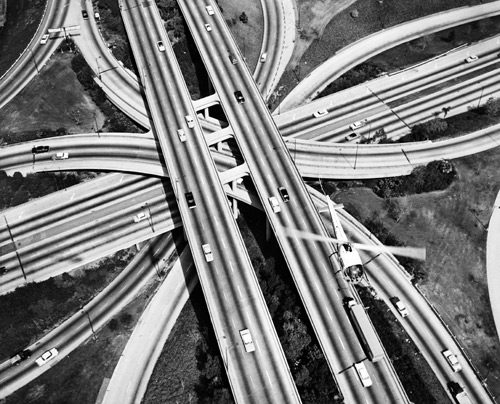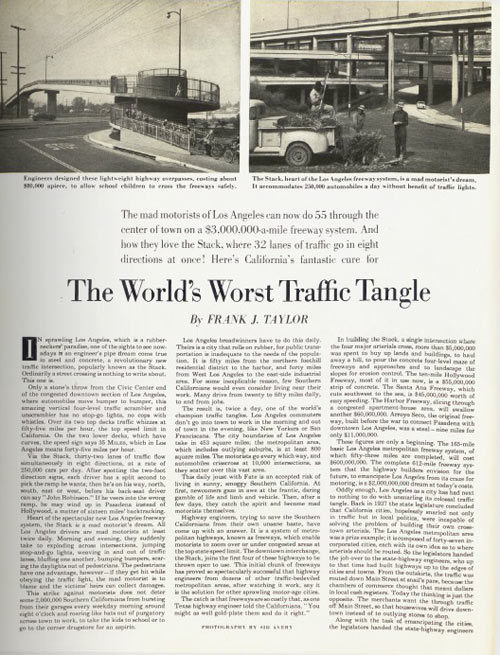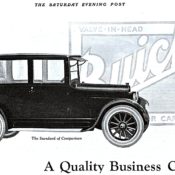 This article and other features about the golden era of American cars can be found in the Post’s Special Collector’s Edition, American Cars: 1940s, ’50s & ’60s.
This article and other features about the golden era of American cars can be found in the Post’s Special Collector’s Edition, American Cars: 1940s, ’50s & ’60s.

Los Angeles launches its freeway system, shortsightedly clearing up a massive traffic tangle, but setting the stage for future traffic nightmares that would dwarf the problem the new roads were meant to solve. Here, a writer unwittingly extolls the “spectacularly successful” solution to one sprawling city’s traffic problem.
—Originally published March 13, 1954—
In sprawling Los Angeles, which is a rubberneckers’ paradise, one of the sights to see nowadays is an engineer’s pipe dream come true in steel and concrete, a revolutionary new traffic intersection, popularly known as the Stack. Ordinarily a street crossing is nothing to write about. This one is.
Only a stone’s throw from the Civic Center end of the congested downtown section of Los Angeles, where automobiles move bumper to bumper, this amazing vertical four-level traffic scrambler and unscrambler has no stop-go lights, no cops with whistles. Over its two top decks traffic whizzes at 55 miles per hour, the top speed limit in California. On the two lower decks, which have curves, the speed sign says 35 MILES, which in Los Angeles means 45 miles per hour.
ow simultaneously in eight directions, at a rate of 250,000 cars per day. After spotting the two-foot direction signs, each driver has a split second to pick the ramp he wants; then he’s on his way, north, south, east, or west, before his backseat driver can say “John Robinson.” If he veers into the wrong ramp, he may wind up in Pasadena instead of Hollywood, a matter of 16 miles’ backtracking.
Heart of the spectacular new Los Angeles freeway system, the Stack is a mad motorist’s dream. All Los Angeles drivers are mad motorists at least twice daily. Morning and evening, they suddenly take to exploding across intersections, jumping stop-and-go lights, weaving in and out of traffic lanes, bluffing one another, bumping bumpers, scaring the daylights out of pedestrians.
Some 2 million Southern Californians burst from their garages every weekday morning around 8:00, roaring like bats out of purgatory across town to work, to take the kids to school, or to go to the corner drugstore for an aspirin.
Los Angeles is a city that rolls on rubber, for public transportation is inadequate to the needs of the population. It is 50 miles from the northern foothill residential district to the harbor, and 40 miles from West Los Angeles to the east-side industrial area.
Highway engineers, trying to save the Southern Californians from their own unsane haste, have come up with an answer. It is a system of metropolitan highways, known as freeways, which enable motorists to zoom over or under congested areas at the top state speed limit. The downtown interchange, the Stack, joins the first four of these highways to be thrown open to use. This initial chunk of freeways has proved so spectacularly successful that highway engineers from dozens of other traffic-bedeviled metropolitan areas, after watching it work, say it is the solution for other sprawling motor-age cities.
—“The World’s Worst Traffic Tangle,” March 13, 1954

Become a Saturday Evening Post member and enjoy unlimited access. Subscribe now




Comments
Very interesting article on the L.A. freeway system as of 1954. Unfortunately things are worse than ever with the freeways, and I try and avoid them as much as possible. Surface streets are another nightmare as well.
When I was on a business trip in 1990 to Atlanta, I couldn’t get over their fantastic MARTA system for going all over the place with no car needed.
Hopefully it’s still as great today.
Very clean, efficient, reasonably priced, I took full advantage of it while there because I knew my embarrassingly backward city would never have such a system. Almost 30 years later (of course) we still don’t, and it’s extremely unlikely we ever will in dopey ‘La La Land’.